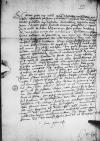Credere potes me nihil operae diligentiaeque omisissem, quo meum ass written over e⌈ess written over e⌉equerer plus quam ms. plusquam(!)
⌈plus quamplus quam ms. plusquam(!)
⌉ parentem. Quarto die ab incepto itinere prehendi iam lassatum itineratione, vegetum tamen ⌊senem⌋. Mirari orig. Myrari⌈MirariMirari orig. Myrari⌉ possis, quantis omnium plausibus excipiatur. In ⌊eo⌋ omnem et totam ⌊Hispaniarum⌋ spem positam locatamque esse uno passim omnes ore conclamant. Equidem misereor huius candoris eo provecti, ut non desint, qui illius prudentiae, cum alias nequeant, hoc modo detrahant tamquam orig. tanquam⌈tamquamtamquam orig. tanquam⌉ meis ille consiliis iter hoc inchoarit. Sed ego quidem facile patiar
cf. Ter. Eu. 381 At enim istaec in me cudetur faba ⌊hanc in me fabam coniectam essecf. Ter. Eu. 381 At enim istaec in me cudetur faba ⌋, quippe qui adversus tales insultus animo sum plus quam ms. plusquam(!)
⌈plus quamplus quam ms. plusquam(!)
⌉ intrepido.
Vicecancellarius encrypted ⌈⌊Vicecancellarius⌋Vicecancellarius encrypted ⌉,[1] quem semper habuit, tandem animum explicavit. Mirabere et hoc, quanto ⌊ille⌋ apparatu ostentationeque hactenus occultarit virus id, virulentissimus homo. Dabitur id saeculo orig. seculo⌈saeculosaeculo orig. seculo⌉ huic saneque infelici orig. infoelici⌈infeliciinfelici orig. infoelici⌉. Lalmant encrypted ⌈⌊Lalmant⌋Lalmant encrypted ⌉[2] apud caesarem encrypted ⌈⌊caesarem⌋caesarem encrypted ⌉[3] instetit encrypted ⌈instetitinstetit encrypted ⌉, ut ait, pro revocatione encrypted ⌈pro revocationepro revocatione encrypted ⌉, sed extra animum, neque adimplebit autem cupiditatem hanc malam. Nescio ominari successum harum rerum, adeo mihi videntur mirabiles.
Italiae encrypted ⌈ItaliaeItaliae encrypted ⌉[4] passim multa [T] encrypted ⌈T undeciphered⌈[T]T undeciphered⌉[T] encrypted ⌉ facturum, modo caesari encrypted ⌈⌊caesari⌋caesari encrypted ⌉[5] visum ita fuerit. Sunt et istic orig. isthic⌈isticistic orig. isthic⌉, qui res regis Angliae encrypted ⌈regis Angliaeregis Angliae encrypted ⌉[6] strenue agunt, sed, ut audio, minime successuris conatibus. ⌊Pontifex(?) encrypted ⌈Pontifex(?)Pontifex(?) encrypted ⌉⌋[7]
fertur praeclara quaedam orig. quedam⌈quaedamquaedam orig. quedam⌉ adversus viceregem encrypted ⌈⌊viceregem⌋viceregem encrypted ⌉[8] gessisse. Nescio, an vobis id quoque constet.
⌊Caesarea est Augusta⌋ ad ⌊Hiberum⌋ flumen, quae nos humanissime excepit. Iam ad loca ea pervenimus, in quibus olim ⌊Caesar⌋ ⌊Petreium⌋, ⌊Afranium⌋ et ⌊Marcum Varronem⌋, ⌊Pompeii⌋ duces, sibi in potestatem redegit,[9] inter ⌊Sincam⌋ scilicet et ⌊Sycorim⌋ satis celebrem ⌊Lucani⌋ etiam ⌊⌋, tribus tantum leucis ab ⌊Ilerda⌋. ⌊Quo⌋ postquam pervenerimus, videbis me copiosius scripturum esse, quandoquidem diem illic Palmarum[10] celebrabimus. Tu interea scribe ad me, quae facies rerum sit ⌊istic orig. isthic⌈isticistic orig. isthic⌉⌋. Plurimum enim id ego scire desidero orig. desydero⌈desiderodesidero orig. desydero⌉. Commendabis autem me imprimis tibi, deinde illustri domino ⌊comiti⌋ et magnificis dominis comitibus palatinis,[11] confratribus meis, quos omnes iubeo tecum rectissime valere.


 BCz, 243 p. 76
BCz, 243 p. 76